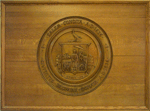McIntire, Samuel: Difference between revisions
From Salem Links and Lore
No edit summary |
No edit summary |
||
| Line 16: | Line 16: | ||
*[http://innopac.noblenet.org/search~S24?/Xmcintire&SORT=D&searchscope=24/Xmcintire&SORT=D&searchscope=24&SUBKEY=mcintire/1%2C11%2C11%2CB/frameset&FF=Xmcintire&SORT=D&searchscope=24&4%2C4%2C The Wood-carver of Salem] by Frank Cousins | *[http://innopac.noblenet.org/search~S24?/Xmcintire&SORT=D&searchscope=24/Xmcintire&SORT=D&searchscope=24&SUBKEY=mcintire/1%2C11%2C11%2CB/frameset&FF=Xmcintire&SORT=D&searchscope=24&4%2C4%2C The Wood-carver of Salem] by Frank Cousins | ||
*[http://innopac.noblenet.org/search~S24?/X%28mcintire%29&searchscope=24&SORT=D/X%28mcintire%29&searchscope=24&SORT=D&SUBKEY=%28mcintire%29/1%2C11%2C11%2CB/frameset&FF=X%28mcintire%29&searchscope=24&SORT=D&2%2C2%2C Mr. Samuel McIntire, carver, the architect of Salem] by Fiske Kimball | |||
Revision as of 10:14, 28 July 2010
Samuel McIntire (1757-1811), widely known for his woodcarvings, was also one of the first architects in the United States. Influenced by Boston's Charles Bullfinch, he gradually learned the profession after years as a master woodcarver.
He became well-known in Salem as an architect after Elias H. Derby hired him to design a home. McIntire went on to design more homes for Derby and soon became sought after by many wealthy Salemites.
Some of his more famous buildings still standing are the Pierce-Nichols House, the Gardner-Pingree House and the Peabody-Silsbee House. Some of his public buildings are the Assembly Hall and Hamilton Hall.
See Also
- Samuel McIntire Salem Focus Website
- Samuel McIntire: carving an American style by Dean T. Lahikainen
- The Wood-carver of Salem by Frank Cousins
- Mr. Samuel McIntire, carver, the architect of Salem by Fiske Kimball
